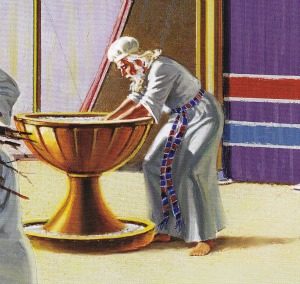Adonai said to Moshe, “You are to make a basin of bronze, with a base of bronze, for washing. Place it between the tent of meeting and the altar, and put water in it. Aaron and his sons will wash their hands and feet there when they enter the tent of meeting — they are to wash with water, so that they won’t die. Also when they approach the altar to minister by burning an offering for Adonai, they are to wash their hands and feet, so that they won’t die. This is to be a perpetual law for them through all their generations.”-Exodus 30:18-21
Alrighty, today we’re going to take a quick look at what is called the Brazen or Bronze Laver.
Interestingly, there isn’t much construction detail provided except that it is to consist of two pieces: a fairly large bronze bowl and a pedestal that the bowl was to rest on.
We aren’t told its dimensions but it had to be pretty big to hold all of the water needed.
The Laver was situated right between the Altar of Sacrifice (the Brazen Altar) and the entrance to the Holy Place.
In terms of how it was used, a priest would approach the Laver and right hand first dip his hands into the water.
Afterwards, he washed his feet with his hands right foot first.
Think of Yeshua washing the disciples’ feet with his hands.
They did NOT dip their feet into the brazen laver.
The hands represent what they did, their service, their work, everything they put their hands to was important and so their hands needed to be cleansed always, and daily.
The initial cleansing was done only once, the daily cleansing was done continuously.
The feet symbolized where they went, their lives and ways.
Their walk had to be a holy walk, so their feet were washed always, everyday.
As mentioned earlier, this washing was a powerful symbolic picture of PURIFICATION & REGENERATION.
Now there is another interesting point that needs to be mentioned.
Whereas your common Israelite was allowed to approach and sacrifice animals at the Brazen Altar, ONLY THE PRIESTS were allowed to used the Brazen Laver.
Keep this fact tucked away in your back pocket because it will come in handy later.
The ritual washing procedures with the Brazen Laver was set apart only for the priests.
Now when I was praying on the spiritual lesson to be gleaned from today’s study, I felt the Lord impressing upon my heart the importance of having proper rituals in our lives.
For example, whether we are consciously aware of it or not, we all have a morning “ritual” when we wake up in the morning.
For some the ritual may be counterproductive consisting of waking up last minute and then in a mad rush scurrying back and forth to take care of our morning tasks before rushing out the door only to find out a few minutes later we had forgotten something.
A much better ritual would be to wake up a bit earlier, get hydrated by drinking a glass of water, do some warm-up stretches, take care of your bathroom duties and then finish up by spending some time praying and meditating on the Word before leaving the house.
Adopting a morning prayer ritual like this sets the tone for the day and puts you in a proper frame of mind to handle whatever the day ahead might throw at you.
The more I study the Priestly procedures, the importance of paying attention to detail and not rushing and doing things in their proper order and timing is greatly impressed upon me.
Our God is a God of order and peace, not chaos and anxiety.




Leave a Reply